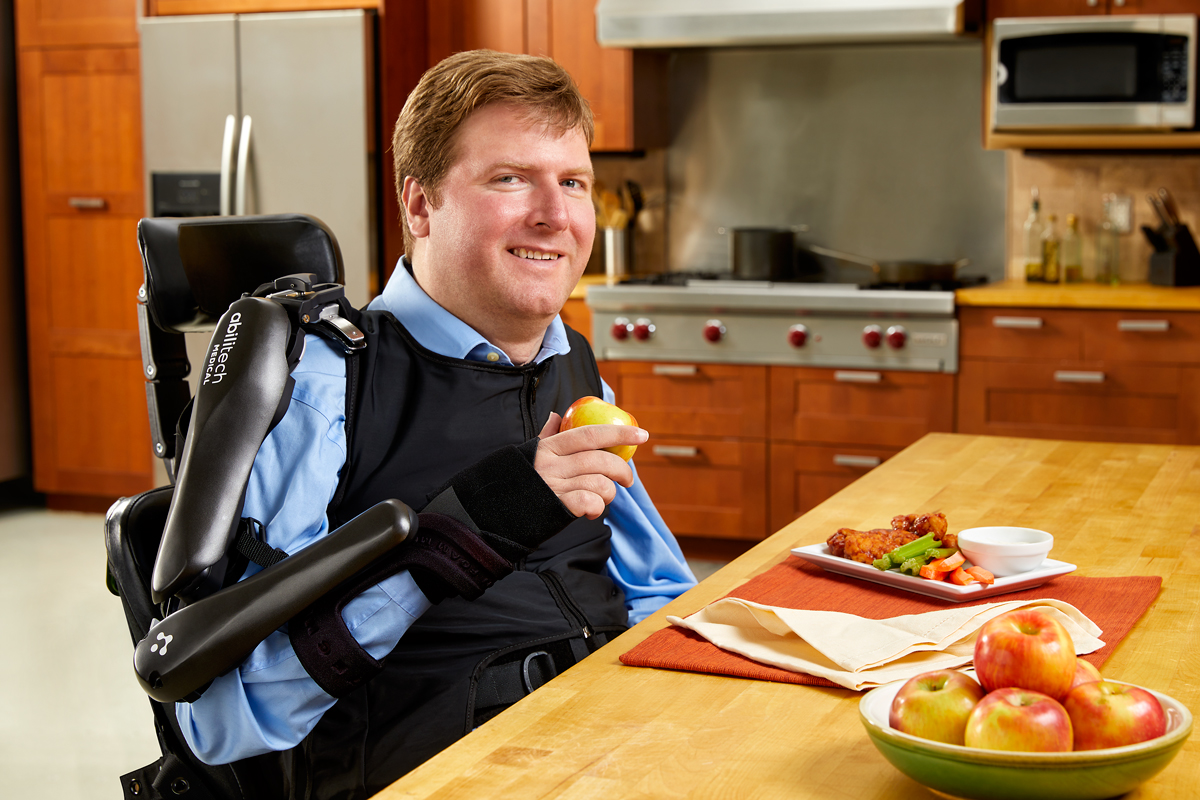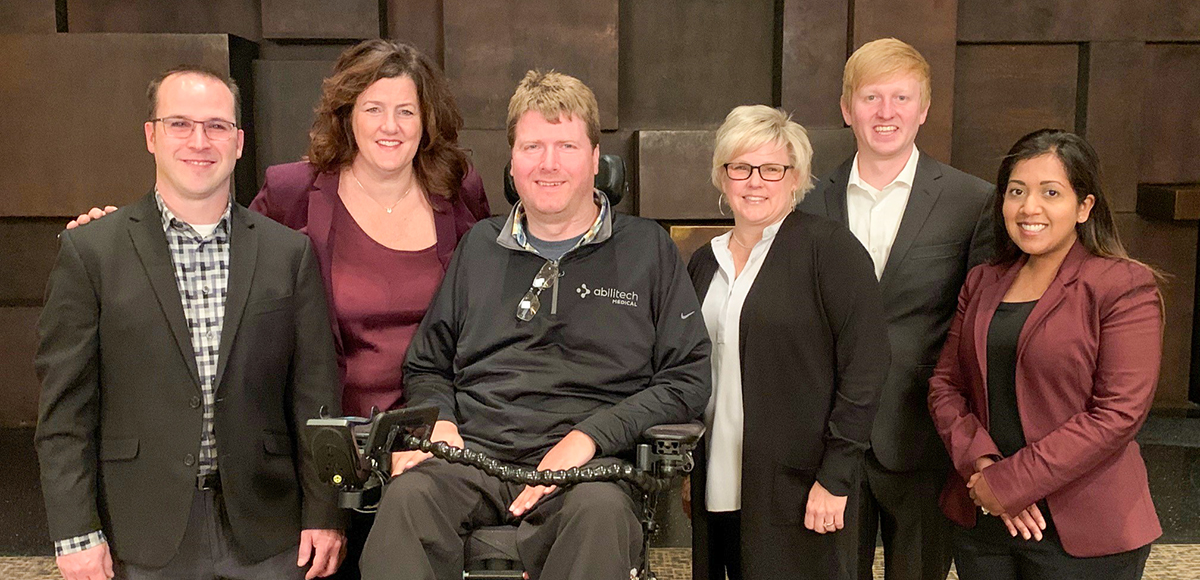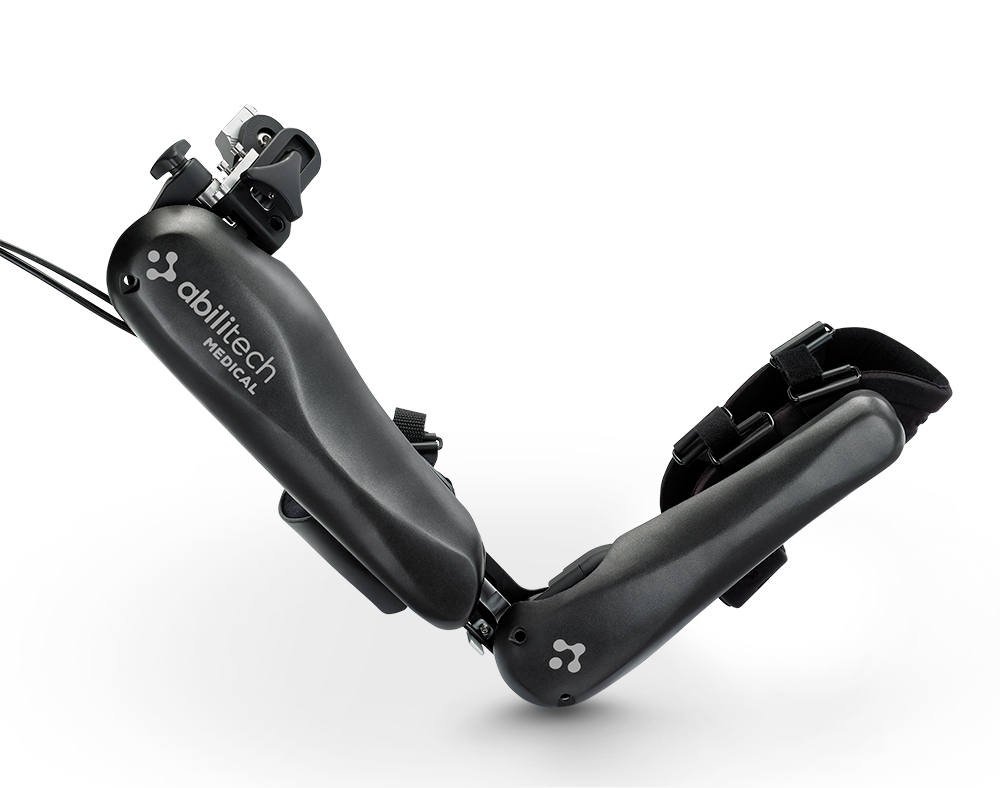Part of the Solution:
How One Company Benefitted From Including Would-Be Users in Product Design

Rob Wudlick’s experience as an engineer and a quad helped to make the Assist both comfortable and useful.
.
I’m an engineer and a spinal cord injury advocate — more specifically, I’m an engineer who lives with a C4 spinal cord injury. In April 2011, while on a 25-day rafting trip with friends in the Grand Canyon, I dove into the river, broke my neck and became a quadriplegic. Before the accident, I lived an active life and had started a career in the outdoor recreation manufacturing field. From the moment of my injury, my goal has been the same — to get my body back. Post-injury, I’ve pursued this through many means.
While much has changed since I was paralyzed, my passion for achieving personal victories remains the same. One victory that always remained out of reach was regaining some of the upper-body function lost due to my injury. With compromised bicep and arm function, even the simplest things became more difficult, like brushing my own teeth, feeding myself, using a computer and opening doors.
As an active advocate for SCI, I am continually meeting new people and organizations that share my passions. A connection with a local nonprofit medical device trade organization led to a meeting with Abilitech Medical, a Minneapolis-based company developing products to restore independence for those with upper-arm weakness or injury. The company was working to bring its first device to market: the Abilitech Assist, a wearable, powered upper-limb orthotic.
From the time I met Abilitech founder and CEO Angie Conley, I was interested in her approach as much as her product. Conley, a former senior product manager at Medtronic, is committed to keeping both users and clinicians actively involved in product development. She believes that medical devices are best designed outside of a formal development lab and with continual input from people who live with the conditions addressed by the device. All of this encouraged me, as a quad and an engineer, and I signed on as the fourth member of the Abilitech team in the fall of 2016.
In the early stages, I helped to develop customer requirements by sharing my experience with other assistive devices that I have used. We had an idea of what we wanted to build, but nothing had been developed yet for a commercial product. It was truly an opportunity to develop the product from the ground up. I stressed and demonstrated the importance of stabilizing the body’s core and of adding support and assistance to the shoulder. This quickly led us to a design plan to help individuals with upper-extremity weakness that also provided us with an advantage over other products currently available.
The Assist fits to the arm and requires a small percentage of its power to be provided by the user to enable a greater range of motion. Springs at the shoulder and elbow support the users’ existing strength, and electronics and software customize the spring tension to support lifting objects of various weights.
The device is designed to be lightweight, easy to use and comfortable.
Joining the Team
Upon joining Abilitech, I was immediately impressed by its inclusive culture and the way the company brings people with disabilities to the table. I see firsthand how this leads to successful designs that solve real problems. We bring in consultants from healthcare, marketing, engineering and reimbursement, and consumer consultants are just as important. My insight and opinions, from design considerations to business strategy, are given the same weight as those from any other member of the team, which has helped make my work meaningful and effective.
As part of a startup organization, I wear many hats — from capturing customer requirements with focus groups and surveys, to contributing to the development of the Assist and our hand grip product, which will be our company’s second device. I develop test plans, help manage projects, perform research and development, and contribute toward intellectual property. I’ve also learned about FDA requirements, entrepreneurial fundraising and the importance of designing for reimbursement.
Abilitech will register with the FDA this year, and has recently secured $9 million to support development and commercialization of its products. Later this year Abilitech will begin clinical studies for MD, MS and SCI to support reimbursement, which will make the devices accessible to more people.
Working for Abilitech has been extremely rewarding. I have seen children, and their parents’ amazement, when the Assist takes what little strength they have and provides the remaining power to move their arms and perform functions that were not viable before. It has also been a powerful experience to help students who’ve interned at Abilitech develop new skills while feeling like we are all making an impact for many individuals.
The most rewarding experience, however, has been using the Assist myself to scratch my face, drink from a water bottle and brush my teeth. After using it, my arm muscles feel physically tired, but in a good way. That’s something I haven’t felt in years. I look forward to having my own personal device to help me live more independently and explore whether the Assist can help me build strength. Anecdotally, I feel like I have gained lasting strength, but we will have to run clinical trials to evaluate the effects and long-term outcomes.
In addition to gains in function from using the Assist, many users report a great emotional impact. Our users have goals that include holding their loved ones again with both arms and eating dinner without needing to have someone feed them.

Abilitech team members pose for a photo at the 2019 Minnesota Cup business competition, where their entry won first place.
.
Our team works with many organizations, clinicians and medical institutions across the nation. One of our main clinical partners is Gillette Children’s Specialty Healthcare Center in Saint Paul, Minnesota — one of the nation’s leading pediatric health centers.
This year, we are looking forward to gathering more evidence for the device through our upcoming 75-person clinical study with those who have muscular dystrophy at the University of Minnesota in collaboration with Gillette Children’s Hospital.
Today, we have a functional device that should soon get FDA clearance and be available to those who need something to help them use their arms again. This likely wouldn’t have evolved into the product it is today if it were not for the guidance of others with neuromuscular conditions and my close involvement as a user and engineer on the team.
Abilitech in the Future
People can begin to purchase the Assist this year. Currently, they can visit the Abilitech website at abilitechmedical.com to learn more about our device and sign up for our newsletter. Abilitech encourages people who want the device to ask for it from their doctors or find a clinician familiar with the device on the Abilitech Medical website. People can also contact Abilitech to assist with reimbursement.
After the Assist is available to the public, we will shift our focus to the Abilitech Grip, a hand grip device which, when used with the Assist, will enable users to actively grab things and lift them. The Grip will include an intuitive user interface that allows a powered actuation of the fingers and thumbs in preferred grip patterns. Currently, I use an assistive glove with the Assist device because I don’t have movement in my hands. When the Abilitech Grip is available, I will have function at the shoulder, elbow, and hand to do even more.
Independence Restored
Restoring independence starts with defining and understanding independence. When companies like Abilitech integrate first-hand, personal insight from the community, more people will benefit from their products. I’m grateful for the opportunity to be the voice of so many who live with upper-limb weakness and to be at the table helping to create the devices that will change lives.
My work with Abilitech is the perfect intersection of my passion to advance solutions for people with spinal cord injury. It brings together my educational experience as an engineer, my interest in entrepreneurial endeavors that focus on helping people and my life experience as a quad that brings meaning to me and will help to restore independence in people’s lives.
How It Works
With the help of the sleek, futuristic-looking Abiltech Assist, people with impaired arm function may soon be able to more easily pick up and manipulate objects such as cups, brushes and forks.
The spring-and-motor powered orthotic is a sleeve that is fitted to the user’s arm and takes advantage of the user’s own strength to lift and manipulate objects weighing up to 12 ounces. Thin cables connect the battery-operated motors to the device’s joints so users may turn their hands palm-side up and back, bend their elbows, straighten their arms, and lift their arms above their heads. Springs at the device’s shoulder and elbow maximize the user’s existing function, and, via software, the springs’ tensions can be customized for the weights of different objects, such as water bottles or cell phones. The orthotic is attached to a lightweight jacket that is intended to make it feel weightless and allows it to be used for a long time.
The company is also working on a companion product it calls Grip, which will similarly take advantage of any existing hand function to allow users better use of their hands and fingers. To learn more about both products, including when they will hit the market, see abilitechmedical.com.
Rob Wudlick helps to raise funds for SCI research through state and federal advocacy. Also, he works on projects at the University of Minnesota and aids in the development of medical innovations that will help people regain movement.
** This post was originally published on https://www.newmobility.com/2020/06/helping-design-a-life-changing-product/


